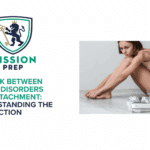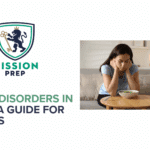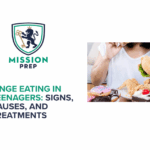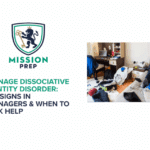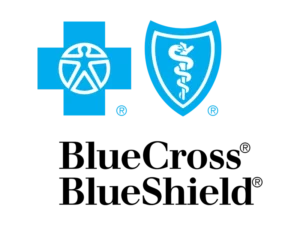Teenage Anorexia: Symptoms, Treatment, & Mental Health Effects of Anorexia in Teens

In the U.S., roughly 3 in 100 adolescents will experience an eating disorder by the age of 18,¹ with anorexia nervosa (AN) affecting the highest number. This is because anorexia does not discriminate, as teens of all ages, ethnicities, backgrounds, and genders can be affected.
Anorexia can gravely affect the mental and physical health of teens, and, unfortunately, is the psychiatric disorder with the highest morbidity rate.8 This may partly come down to how it often shows alongside mental health conditions such as depression, anxiety, obsessive compulsive disorder (OCD), and suicidal ideation.
If you suspect that your teen has anorexia, professional medical and mental health advice is strongly advised. The disorder can worsen without treatment and may continue into adulthood without timely support.
This guide can help you better understand teenage anorexia, as it covers:
- How to understand teenage anorexia
- Mental health effects of anorexia
- Warning signs of anorexia in teens
- How to manage anorexia in teens, including treatment options

Understanding Teenage Anorexia
Anorexia nervosa (AN) is a serious mental health condition that can affect teens from all walks of life.
Anorexia doesn’t just happen out of the blue, and may even begin with “healthy” intentions around eating less and exercising more. However, in anorexia nervosa teens, rules around food and body checking can quickly become rigid. For example, their thinking may become inflexible and driven by anxiety.
According to the Diagnostic and Statistical Manual of Mental Disorders, Fifth Edition (DSM-5), anorexia must have all three of the following symptoms for a diagnosis:
- Restriction of energy intake: Eating much less food than the body requires, typically leading to significantly low body weight for age and developmental stage
- Intense fear of gaining weight: A fear of weight gain exists even if a teen is underweight and is not eased by further weight loss. In general, this fear continues to grow over time
- Body dysmorphia: Someone seeing themself as overweight even when medically underweight. Or, their self-worth becomes completely tied to body size and shape
Teens with anorexia typically start to avoid meals, increase exercise to “earn” meals, and avoid talking about or get defensive about these changes. Families can even start to see personality shifts, such as a formerly relaxed teen becoming perfectionistic, irritable, or withdrawn. However, early diagnosis can make a world of difference, as it can lead to better outcomes for your teen.¹
Further, getting an assessment even when they don’t “look sick” can matter. Atypical anorexia can mean weight in a normal range, so it’s important to remain vigilant if you notice obsessions about food and body weight creeping in with your child.
Sometimes, understanding the causes of anorexia can help you better understand where this disorder comes from, allowing you to approach your teen with compassion and support.
What Causes Anorexia?
Families, social media trends, and talking about weight don’t necessarily cause an eating disorder like anorexia. However, these factors can play a role in how it develops.² It’s important to note that anorexia isn’t caused by one single factor – a combination of things like genetics, biology, environment, and psychological makeup can all play a role.
For example, a biological predisposition to lower levels of the neurochemicals serotonin and dopamine may factor into the development of AN. As can unusual activation of the neural system that manages appetite and fear (corticolimbic system) and those that control habitual behaviors (frontostriatal circuits).
Further risk factors include childhood obesity, pre-existing mood disorders, personality traits like perfectionism, and childhood adversity such as abuse. Also, being exposed to family members who have a hyperfocus on issues such as weight could also contribute to the development of anorexia.9
Social media (and media in general) can also play a role, especially in cultures that promote a thin body image as the “ideal.” Also, even the profession a teen aspires to could factor in, as certain jobs are associated with lean body weight.
In general, low self-esteem is considered to be at the root of anorexia, regardless of how this low level developed. Therefore, if a teen experiences struggles around their weight, body shape, and how clothes fit them, anorexia can make its way through these cracks. They may start to be dictated to by the “anorexia voice,” which could feel soothing in the short term – but is damaging to both mental and physical health.
Who Is at Risk for Anorexia?
As mentioned, teens from any background can develop anorexia nervosa – even though there are certain risk factors.
Yet certain populations are potentially more at risk, for example, females are twice as likely to develop anorexia as males.3 However, it’s important not to assume that only girls can develop an eating disorder, as anorexia in boys and gender-diverse youth is particularly under-recognized.³
The reality is, anorexia does not discriminate; it can happen to anyone, irrespective of race, gender, faith, or family structure. Plus, many teens struggle to admit what they’re going through, usually until anorexia has taken root, and adults may misread or dismiss signs as typical changes in teens.
Further, as discussed, teens with a history of abuse or mental health conditions such as depression and anxiety may be more at risk. Therefore, if signs of low mood appear alongside changes in eating patterns and attitudes, it may be important to take notice.
Mental Health Effects of Anorexia in Teens
Anorexia affects every part of a teen’s health: mental and physical. When a teen severely restricts how much and how often they eat, this typically leads to malnutrition, potentially altering brain structure and crucial body functions.
Neuroimaging research shows reduced gray-matter and cortical thinning during acute anorexia.⁴ These changes affect attention, memory, cognitive flexibility, and emotional regulation, which explains why school becomes harder and social situations often feel overwhelming for a teen with anorexia. Additionally, cognitive fog can make decision-making around meals especially stressful, and they may become even more rigid about rituals that “quiet” their anxiety. However, this is likely the anorexia taking a stronger grip.
As mentioned, anorexia often co-occurs with other mental health conditions. In fact, people with anorexia may be four times as likely to have another psychiatric condition. Plus, this relationship goes both ways, as people with pre-existing psychiatric conditions are four times more likely to develop anorexia than the general population.10
Aside from the mental health effects of anorexia, teens with it may also experience physical impacts, such as low heart rate and blood pressure, orthostatic dizziness, cold intolerance, fatigue, gastrointestinal discomfort, and missing periods or stalled puberty.² If these effects continue, bone health can become vulnerable and risks of fractures may be higher.
Clearly, the mental and physical effects of anorexia can be severe and concerning, making recognizing the warning signs vital for intervention. We cover these next.
Warning Signs of Anorexia in Teens
The warning signs of anorexia in teens include physical, behavioral, and emotional symptoms. To help raise awareness of these, we’ve broken them down into their categories below.
Physical Signs of Anorexia in Teens:
- Noticeable weight loss
- Delays in growth for developmental age
- Persistent fatigue, dizziness, or fainting
- Cold sensitivity
- Sleep disruption
Behavioral Signs of Anorexia in Teens:
- Skipped meals
- Rigid “food rules”
- Food avoidances
- New eating habits such as chewing ice cubes or counting calories
- Compulsive exercise
- Overusing medications such as laxatives or diuretics
- Consistent visits to the bathroom, especially after eating
Emotional Signs of Anorexia in Teens:
- Perfectionism around body shape and weight
- Intense body checking
- Anxiety and irritability, especially around meals clothes
- Refusal to talk about habits around food or weight loss
- Social withdrawal, such as avoiding eating with family and friends
While these are the typical signs of anorexia in teens, there may also be ones which could potentially be life threatening if left without medical attention. Therefore, it you notice any of the following signs in a teen, seeking urgent medical care is important.
How to Manage Anorexia in Teens
Families sometimes wait for an extreme change in their teen before seeking help. Yet, as with many mental health conditions, anorexia is best targeted early to limit its potential mental and physical impacts. Therefore, seeking support as soon as you notice consistent and concerning changes can make a difference for long-term recovery.
Medical safety checks, referrals to eating-disorder-informed providers, and clinician-guided support at home can help protect your teen’s health while keeping a more serious crisis at bay.⁵
The first step in this process is making an appointment with your doctor for a screening test. While they will ask your child about their symptoms, keeping a diary of observations about your teen’s eating habits, energy, mood, and activity patterns can also help inform this visit.
During the assessment, your doctor will likely check vitals, including:
- Heart rate and blood pressure
- Weight and height in comparison to developmental trends
- Electrolytes
- Kidney and liver function
While your doctor may recommend a referral to eating-disorder-informed care, it’s important not to just “wait and see.” You can advocate for your child’s well-being by questioning where referrals will be made to, who will monitor medical stability, and who will guide nutrition.
When a referral is made, an eating disorder specialist can talk to you about the right types of therapy based on your teens symptoms and needs. This process can reduce uncertainty and help you and your teen move from worry to stability.
Treatment Plans for Teens With Anorexia
Anorexia treatment programs for teenagers should consider both the physical and mental symptoms of the disorder to manage any risks and improve daily functioning.⁷ Therefore, medical and nutritional supervision is typically balanced with psychotherapy.
For example, CBT-E (a form of cognitive behavioral therapy) can helps teens identify and change unhelpful thoughts and behaviors tied to eating and body image while building relapse-prevention skills.
Additionally, family-based treatment (FBT) can empower parents to restore healthy eating patterns at home with real-time coaching. This process gives caregivers the control over meals and nutrition, before gradually transitioning power back to the teen.
Medications do not “cure” anorexia, but they may be prescribed if issues like co-occurring anxiety, OCD, or depression in teens is fueling eating disorder symptoms.
Treatment plans for teens with anorexia can also be delivered in the following packages:
- Outpatient care: Supports medically stable teens with medical monitoring, nutritional guidance, and anorexia therapy for teenagers such as CBT-E or FBT
- Intensive outpatient (IOP) and partial hospitalization (PHP): These add structured meals, skills groups, and daily therapy while the teen goes home in the evening. This may be useful when outpatient support isn’t enough or the family needs extra support
- Teen anorexia residential treatment: Provides 24/7 therapeutic structure for teens that need round-the-clock support. The right program should be adolescent-specific and trauma-informed, and include family coaching
Choosing a Treatment Plan for Your Teen
Choosing the right anorexia treatment plan involves observing patterns, making notes, and asking the right questions. For example, you could ask yourself:
- Are my teens vital signs unsafe?
- Is my teen unable to complete meals at home?
- Are compensatory behaviors such as exercise, counting food, skipping meals, getting worse?
- Do I feel incapable of supporting them adequately at home right now?
If the answers to these questions are “yes,” then more intense or residential settings may be most appropriate for your child’s needs. However, if you feel capable of supporting them at home and their life is not at risk, outpatient treatment may be enough.
Regardless of type, the best treatment plans take into account how much parents will be involved in meals, including how feared foods will be approached. Plus, accommodations may be needed at school around sports, activities, and mealtimes.⁵ Professional nutrition management is typically an integral part of this process.
Family involvement can reduce blame and build consistent responses to the illness rather than to the teen. Further, parents can provide steadiness during hard moments; sitting through meals, tolerating distress, and keeping the plan predictable. This steadiness helps the brain “re-learn” safety with food and reduces the pull and pressure of anorexia rituals. Over time, as health stabilizes, teens can reclaim age-appropriate control, and families shift from coaching to being supportive partners in the recovery plan.
Finally, treatment should eventually work on a gradual return to everyday routines at home and in school, and help them build relapse-prevention skills. With consistent support from family, specialist teams, and school, a teen can rebuild their life and engage with friends, academics, and hobbies.⁸

Mission Prep: Professional Support for Teenage Mental Health
Recovery for teens with anorexia isn’t about perfection, it’s about working on improving thinking and behaviour patterns around food, weight, and body concerns until healthy habits feel consistent and self-directed. Family coaching can also play a vital role in keeping teens safe and on the path to recovery.
Mission Prep doesn’t directly treat eating disorders, but we can support your family with practical resources and care navigation. Our team can also provide coordinated support for conditions that often fuel eating disorders, such as anxiety, OCD, depression, ADHD, or trauma. Therefore, your teen’s medical, nutritional, and mental health needs are addressed together.
If you’re ready to take the next step in your teen’s recovery, or are interested in learning more about our services, reach out to our licensed, compassionate team today.
References
- American Psychiatric Association. (2013). Diagnostic and statistical manual of mental disorders (5th ed.). Washington, DC: Author.
- Hornberger, L. L., Lane, M. A., & Committee on Adolescence. (2021). Identification and management of eating disorders in children and adolescents. Pediatrics, 147(1), e2020040279. https://doi.org/10.1542/peds.2020-040279
- National Institute of Mental Health. (n.d.). Eating disorders – Statistics and facts (NCS-A). https://www.nimh.nih.gov/health/statistics/eating-disorders
- King, J. A., & Ehrlich, S. (2018). Structural neuroimaging of anorexia nervosa: Gray-matter changes and recovery. Biological Psychiatry, 83(3), 213–221.
- American Psychiatric Association. (2023). APA practice guideline for the treatment of patients with eating disorders (update). American Journal of Psychiatry.
- Lock, J., & Le Grange, D. (2015). Help your teenager beat an eating disorder (2nd ed.). New York: Guilford Press.
- Miskovic-Wheatley, J., Hurst, K., Byrne, S., Madden, S., Touyz, S., & Hay, P. (2023). Eating-disorder outcomes: A rapid review and meta-analysis. Journal of Eating Disorders, 11, 56. https://doi.org/10.1186/s40337-023-00756-y
- Auger, N., Potter, B. J., Ukah, U. V., Low, N., Israël, M., Steiger, H., & Paradis, G. (2021). Anorexia nervosa and the long‐term risk of mortality in women. World Psychiatry, 20(3), 448. https://doi.org/10.1002/wps.20904
- Moore, C. A., & Bokor, B. R. (2023, August 28). Anorexia nervosa. In StatPearls. StatPearls Publishing. https://www.ncbi.nlm.nih.gov/books/NBK459148/
- Momen, N. C., Plana-Ripoll, O., Yilmaz, Z., Thornton, L. M., McGrath, J. J., & Bulik, C. M. (2022). Comorbidity between eating disorders and psychiatric disorders. International Journal of Eating Disorders, 55(4), 505–517.

